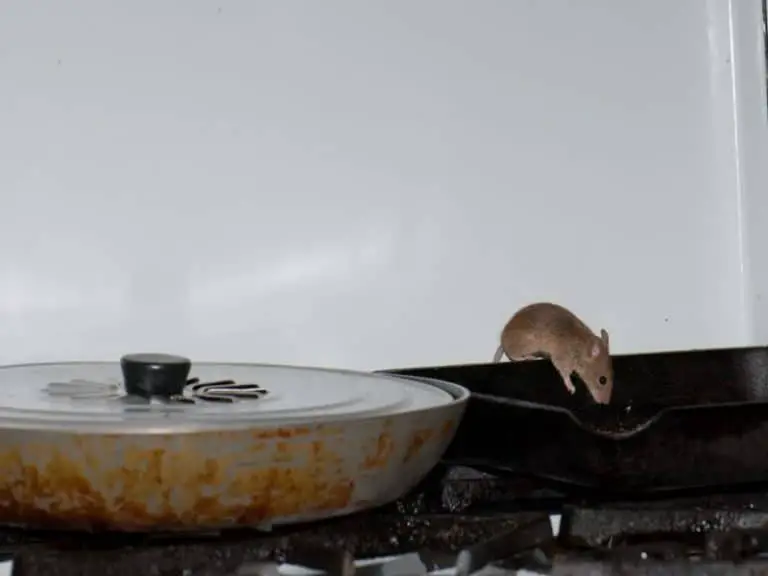How To Seal Around Pipes To Prevent Mice
The best way to keep out mice from your home is to eliminate its entry points. One of the most common areas that many homeowners neglect is the pipes. Mice can pass through gaps as small as 0.6cm; therefore, if a mouse gets its head through, its body will also follow.
When sealing up holes/dents around pipes to prevent mice, you need to identify all the holes first. Once you have located where the holes are, you need to seal them properly depending on the size of the hole with either all purpose silicon caulk or spray foam sealant.
No matter how tight the fit is, there is still a gap remaining around pipes, especially routed through brick walls.
Thankfully, there are different ways on how to seal these gaps, but the type of sealant you choose will depend on the size of the gap.
Pro-tip: Do you know that there is a better way to catch mice than traditional mousetraps that kill mice? Check out the humane mousetraps on Amazon.com now.
Caulking
Caulk is a flexible material that is used to seal air leaks found through cracks, gaps, or joints that is less than a quarter of an inch wide between stationary building components and materials.
Before you caulk leaks, you need to detect all the leaks first and assess your ventilation needs to ensure that you have sufficient indoor air quality.
Aside from sealing air leaks, it can also prevent water damage interior and exterior of the house when applied around faucets, water pipes, drainage, ceiling fixtures, and other plumbing fixtures.
How To Select Caulk?
Most caulking compounds are made from disposable cartridges that fit n half-barrel caulking guns.
If possible, look for an automatic release caulking gun to make work easier and more organized. But, if you purchase pressurized cartridges, you no longer need caulking guns.
Caulking compounds come in a variety of forms such as aerosol cans, squeeze tubes, and ropes for special applications. They also vary in strength, properties, and prices.
Caulking compounds come with water-based caulk, which can be cleaned with water and solvent-based compounds that require a special solvent for cleanup.
Common Caulking Compounds
GE Sealants & Adhesives All Purpose Silicone Sealant
- 100% silicone formula that offers protection from water damage and in areas that are prone to water and weather exposure.
- 7-year protection against stain-causing mold and mildew growth
- Provides excellent flexibility and strong adhesion for both interior and exterior projects
- Ready for rain exposure within the same day
- Can resist freezing temperature and UV degradation
Tremco Polyurethane Sealant
- Designed for interior and exterior use
- No primer required
- Applies with conventional caulking guns
- Excellent general-purpose sealant designed for use in the window frame, precast, masonry, and other similar types of construction joints.
- Suitable for continual immersion in water using the appropriate primer
GREAT STUFF PRO Insulating Foam Sealant
- Comes in a reusable can
- Minimal expanding for general purpose
- Fills gaps and expand to take the shape of cracks and voids
- Forms permanent, water-resistant, airtight bond to vinyl, wood, and metal surfaces
How To Apply Caulk?
Although caulking is not high-tech protection, it can be tricky. Here is a guide on how to apply caulk:
- Dust the area around the pipe using an old paintbrush or handheld duster to clean dirt, dust, and other debris.
- Load the caulk gun with the preferred caulking compound of choice. Acrylic and latex-based caulking compounds are designed for exterior applications. They are ideal for sealing tiny gaps with a size of half an inch around the perimeter of the pipe.
- Apply an even amount of caulking material around the perimeter of the pipe.
- Wipe the caulking with your finger to smoothen the material. You may use a damp rag to finish off excess caulking.
Tips When Applying Caulk:
- Remove any old caulk and paint using a knife, stiff brush, screwdriver, or special solvent. Make sure that the area is dry so that you won’t seal in moisture.
- Hold the caulk gun at a consistent angle. You know you got the right angle when the caulk is immediately forced into the gap as it comes out of the cartridge.
- Caulk in one straight continuous stream. Avoid the stop-and-start scheme when caulking.
- Apply caulk at the bottom of the opening to avoid bubbles.
- Make sure that the caulking materials stick at both sides of the gap or crack.
- Release gently the trigger before you pull the gun away to avoid applying too much of the material. Hence, a caulking gun with an automatic release will help you solve this problem.
- If the caulk material oozes out of the crack, use a knife to push it back in.
- If the caulk shrinks, make sure to reapply it to form a smooth bead that will seal the gap completely.
When Is The Best Time To Apply Caulk?
The best time to apply caulk is during dry weather wherein outdoor temperature exceeds 45 degrees Fahrenheit.
Low humidity is important during the application, as this can help prevent cracks from swelling with moisture.
Warm temperature is also necessary so that the caulk will set properly and adhere easily to the surface.
Aerosol Foam Sealant
Spray foam sealants are used to fill large gaps around pipes, window frames, and more.
The foam is applied directly from the container and expands to fill the gap that is sprayed. It comes with a soft, spongy texture that allows the foam to be trimmed with the surrounding surface.
Spray foam sealants do not change shape when they are dry, so they should not be used where the gap is expected to move or change in size. It is versatile and can seal wall cavities, exterior walls, attics, small gaps, and cracks in the house.
Best Aerosol Foam Sealant
If you have spotted the cracks and dents, make sure to wear your PPEs then get ready on for my picks for the best foam sealants on Amazon.
Loctite Titefoam Insulating Foam Sealant
This foam sealant has several features, which are designed to make it effective and easy to use.
It’s is supposed to be quadruple times as dense as regular foam sealants that offer extra insulation and blocks air more properly. It comes out as a bright white foam with UV resistance, which is designed to resist cracking.
However, be cautious when using this product outside as it requires the protective covering to make the product work efficiently.
What I Like:
- It is designed to be extra dense
- It is affordable
- Superior flexibility
- Can withstand harsh UV rays
What I Don’t Like:
- The nozzle is somewhat leaky
- The product can seal the applicator if you are not careful when using
Great Stuff Smart Dispenser Gaps and Cracks
This foaming sealant features the same standard formula that the brand, Great Stuff has been known for, except that the nozzle is redesigned.
The improved nozzle design is added to make the product easier to reuse. As stated as one of its features, the product can be reused for up to one month.
The straw tip closes once you release the trigger, which helps in reducing the foam from dripping out and blocking the opening (a common problem with canned foam sealants).
Moreover, it can fill gaps up to 1cm wide.
What I Like:
- The redesigned nozzle improves the reusable value of the product for up to one month after opening
- The foam stop when you stop, which is precise and allows you to have great control
- It is simple to use and cost-effective
- Comes with a redesigned smart dispenser straw
What I Don’t Like:
- Leaks can occur
- The nozzle can dry when not properly used
DAP Touch ‘n Foam Expanding Sealant
This option is more expandable than other items listed, which makes it a good pick for filling any larger gaps you may have.
It can expand as wide as 1” or larger, while other options on this list are only suitable for ¾” to 1” gaps.
This foam sealant is weather-resistant; therefore, it can effectively block out any escaping air while keeping the moisture out. It comes out in cream/tan color.
What I Like:
- It is weather-resistant
- It can block insects and other pests
- It is good for indoor and outdoor use
- It is suitable to use for larger gaps
What I Don’t Like:
- It is stated as reusable, but it is difficult to use the second time
- Filling gaps can be tricky
Dow Chemical Expanding Foam Sealant
This Fill and Seal triple-expanding sealant is used to prevent drafts and pest incursions into your home.
It can be expanded up to three times the applied volume and can form an airtight and waterproof bond. It can be applied to wood, metal, glass, masonry, and plastics.
What I loved about this product is that it leave dry tack-free within 15 minutes and fully cure within 8 hours.
What I Like:
- It is highly durable
- Minimally expanding and requires low pressure
- Suitable to use in windows, doors, pipes without obstructing their normal operation
- Contains 20-ounce of the product
What I Don’t Like:
- Spray gun attachment is required and is sold separately
How to use aerosol foam sealant?
Foam sealant is effective for sealing gaps around the pipes, which are greater than half an inch.
Either it is expanding or non expanding, foam sealant is a good choice for sealing the gaps. When using aerosol foam sealant, here is a simple guide on how to do it:
- Dust the area around the pipe with an old paintbrush or hand-held duster to get rid of dirt, dust, and other debris
- Make sure that the area is well-ventilated. Wear protective gloves, eye gear, and a respirator if possible.
- Apply the foam sealant on the gap around the pipe’s perimeter.
- Once the foam sealant is applied, allow it to dry thoroughly before removing any excess sealant.
- If the sealant is already dry, remove any excess sealant by trimming the foam sealant with a sharp knife.
Tips when using foam sealant
- Protect your lungs with a respirator and make sure to wear proper gear such as a full protective suit, chemical-resistant gloves, and wrap-around goggles.
- Never spray foam sealant on wet surfaces with a moisture level of more than 20 percent; otherwise, the foam will not stick.
- Before installing the first tip, point the gun to an empty box or garbage box, and then pull the trigger until both chemicals are flowing evenly.
- Always follow the manufacturer’s instructions on proper operation, tip changes, storage, and disposal.
- Always wait a couple of minutes before spraying additional lifts, and never spray a lift of more than two inches thick.
- Before you start, shake the can to mix the content. Shake every few minutes after every use.
Well, these are the two common ways to seal pipes, but there is still one method that is still used nowadays in sealing holes/cracks in the pipe, and that is with the use of cement.
How to seal pipe with the use of a cement
- Prepare the hole by using a hammer and chisel to square the edges. Make sure not to make any damages on the pipe.
- Dust the area around the pipe using an old paintbrush or hand-held duster when removing dirt, dust, and other debris.
- Using a margin trowel, mix a small amount of cement in a bucket. Cement is an ideal material to fill gaps/holes in the pipe that is greater than ½ inch.
- Apply the cement around the pipe using the margin trowel. Work the cement into the gap to fill the void behind the surface if necessary.
- Once the cement is dry, wipe it using a damp sponge to make it smooth.
General tip:
- When filling large gaps and voids, use a combination of foam sealant and cement stucco
- To provide a more natural finish on the surface that is surrounding the pipe, you may fill larger voids with a foam sealant first, then apply the cement.
Finally, you have learned all the methods of sealing pipes; however, remember that there are other passageways (aside from pipes) where mice can enter your house, and that is in the house foundation.
How To Seal Up Holes In A House Foundation To Keep Out Mice
Look for holes in the foundation wall
Using a box of toothpicks or wooden matches, go into your crawl space and check for holes on each foundation wall. Anywhere you can spot sunrays is a potential entry for mice.
Insert a match or toothpick into the small holes, so that the end of the stick is sticking outside the house.
Fill in holes and cracks with silicone caulk
Fill in holes and cracks that are less than ¼ inch in size with silicone caulk and a caulking gun from the outside.
Inspect around the perimeter of the foundation, and then look for the matches/toothpicks that you stuck out. Make sure to pull them out before you start caulking.
Stuff some hardware cloth into the hole
Get a hardware cloth, and then cut six square inches together with a pair of tin snips for holes with a circumference of around ¼ to ½ inch.
Once you have cut the given measurements, stuff the hardware cloth into the hole, make sure that it is below the surface of the foundation. Cover the stuffed hardware cloth and the hole with caulk.
NOTE: Though other related posts will require you to use steel wool in stuffing holes, avoid using it since it is prone to rust and will deteriorate over time.
Measure bigger holes with a tape measure
For holes that measure larger than ½ inch, measure them using a tape measure to get the correct measurements. Cut squares of hardware cloth 2 inches wider than the measured hole with the tin snips.
Apply cement for larger holes
Hold the hardware cloth flat over the hole and patch in some cement over the hardware cloth using a putty knife. Then, cover the cloth and the hole with the cement patch. Smoothen the patch using a putty knife.
Where To Look For Gaps Or Holes Inside And Outside Your House
According to the Centers for Disease Control and Prevention, you can prevent rodents from entering your house by checking the inside and outside of the house for gaps and holes.
Interior Of The House
- Around the fireplace
- Around doors
- Inside closets near the floor corners
- Inside, under, and behind kitchen cabinets, stoves, and refrigerator
- Inside the attic
- In the basement or crawl space
- Around floor vents and dryer vents
- Around the pipes under sinks and washing machine
- Around the pipes going to water heaters and furnaces
- In the basement and laundry room floor drains
- Between the floor and wall juncture
The Exterior Of The House
- Under doors
- Around the foundation
- Around doors
- Around windows
- In the roof among the rafters, eaves, and gables
- Around holes for electrical, plumbing, cable, and gas lines
- Garages
Wrap Up
To prevent mice from entering your house, check to know all the possible entry points of your house, and then make sure to seal them properly with any of the methods discussed above.
Knowing this information beforehand can help in making your house free from mice; therefore, saving you time and money from future damages brought about by mice infestations.
Medical Disclaimer: TheHomePestControl is a digital publisher and does not offer personal health or medical advice. The contents of this website are not intended to substitute for professional medical advice, diagnosis, or treatment.
Affiliate Disclaimer: As an Amazon Associate, I earn from qualifying purchases made on our website. If you make a purchase through links from this website, I may earn a commission at no additional cost to you.













